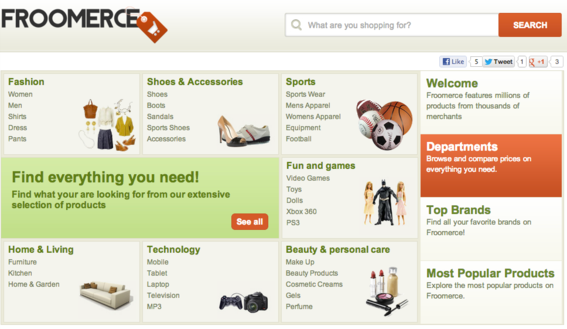Social shopping sites can assist consumers to find products. You are likely familiar with popular sites that fit into this category — Etsy, Fab.com and Pinterest, in particular. But here are seven others that may be used by smaller retailers to list products for sale.
1. Blomming

Blomming shops can be set up on blogs and Facebook pages.
Merchants can use Blomming to create up to three fully functional shops on Blomming.com, their own blog or website, and within a Facebook Page.
After registering, merchants upload photos of products they want to sell and then set price, quantity and include keyword tags for use when customers search the site. Merchants can also copy a personalized “embed” code and paste it wherever they want. Blomming manages ecommerce transactions with a shopping cart, checkout, payments and tools for tracking orders and contacts.
2. Ownza

Social shopping site Ownza resembles Pinterest.
Ownza allows anyone to share, discover and discuss products. Registered users create “ownership profiles” with links to products they either own or want. The site also allows retailers to create storefronts — which are really just profiles — where they can post links to their products.
Ownza borrows design inspiration from Pinterest through a heavy emphasis of photo images and pinboard style layout. Even further, it mimics Pinterest functionality by allowing users to add content from anywhere on the web and organize it into what the site refers to as “shelves.”
Users receive discounts on purchases based on their level of participation, and are encouraged to submit products and share them with their friends on social networks.
3. Daily Grommet

Daily Grommet curates, tests and reviews products.
Daily Grommet is a curated online marketplace and video review site where shoppers can discover and purchase products from independent retailers. According to the website, Daily Grommet “seeks out unique products, carefully tests them, and produces a video review of each one telling the story behind its creation.” The site allows registered users to suggest products and specializes in those that are innovative and ecologically responsible.
Not every merchant can qualify to have products featured on the site, however. “We don’t tend to work with merchants as much as we do with manufacturers,” said Jules Pieri, Daily Grommet’s founder and CEO. That does not exclude smaller retailers who create their own products such as jewelry, art and clothing, for example.
“The site receives approximately 100 ideas per week, half of which come from manufacturers or creators,” said Pieri. She added that merchants who wish to have products featured on Daily Grommet can submit them through email, Twitter, or via “Citizen’s Gallery” on the site.
4. Lish

Lish is a social product discovery site created by Payvment.
Retailers that use the popular Facebook shopping cart Payvment now have an added advantage thanks to Lish.com, a new site designed especially with product discovery in mind.
Lish delivers a real-time feed of trending products from Payvment’s Facebook shopping mall. Items are featured on Lish based on feedback gleaned from the shopper community. The feed stream is continually updated as new information is fed into it based on what items are trending in the mall.
“Lish.com recreates the serendipitous discovery and impulse buying experience that makes shopping in the real world so much fun,” said Payvment CEO Jim Stoneham. “We feel this (impulse purchasing) is an untapped opportunity that meshes nicely with social discovery.”
5. Second Shoutout

Second Shoutout features vintage and antique merchandise.
Sellers of vintage merchandise may consider Second Shoutout, a site that focuses on antiques and vintage products — including art, clothing, home decor, furniture and jewelry. The site, which promotes itself as an online version of a flea market or tag sale, emphasizes sharing the retailer’s “story” with customers through the use of interviews, videos and special promotions.
6. Froomerce

Froomerce enables merchants to market products across multiple channels.
Froomerce is a multi-channel, ecommerce marketing platform that enables retailers to create a virtual storefront, market products across multiple channels – web, social media and mobile – and fully manage the store without the use of highly technical integration.
Users browse the Froomerce site across a variety of categories to discover products from participating merchants, make purchases, rate and review products, and share them with their friends on Facebook and other social networks.
7. Silkfair

Using Silkfair, merchants can build standalone storefronts.
Silkfair offers merchants the ability to create an online marketplace within the site – which it refers to as a “market booth” – and to build a standalone online store. No technical knowledge is required to create a booth or store, but design customization options are included for those that know HTML.
Shoppers can browse, purchase and share products across a range of categories, from art to video games.




